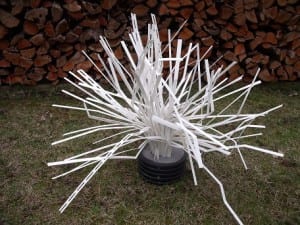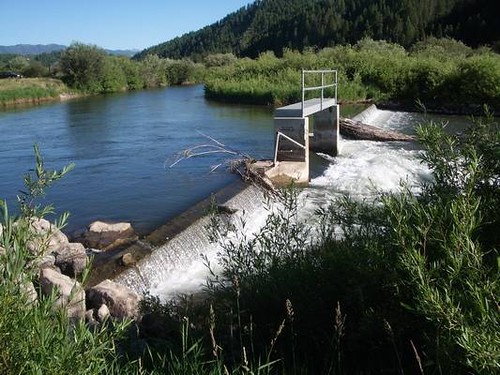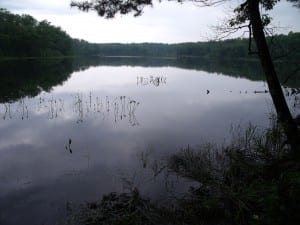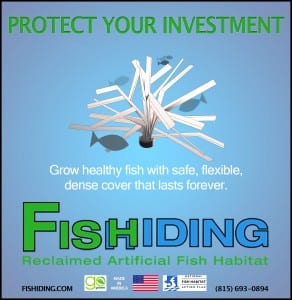Diamond mining company De Beers lobbied government officials to allow them to drain a lake in the Northwest Territories, decimating local fish habitat, in order to move forward with its Gahcho Kue diamond mine. See the dozens of unique artificial fish habitat models, fish attractors and fish cover used at fishiding.com, the leader in science based, proven, fish protection.
Tag: pvc fish habitat
Underwater cannon can protect valuable fish in the Great Lakes
| Michigan: Scientists Will Chase Invading Fish With Cannon | |
| Source: The New York Times; National Briefing-Midwest – By THE ASSOCIATED PRESS. Published: December 30, 2011 Scientists are trying to discern whether an underwater cannon can protect valuable fish in the Great Lakes from the round goby, a predator that lurks near spawning beds and gobbles up the eggs of lake trout and whitefish. Biologists plan to use a seismic gun next fall to chase the predatory fish from several Lake Michigan reefs. Researchers hope the gobies will stay away long enough for native fish to hatch and escape. The experiment is part of the increasingly sophisticated war against invasive animals and plants that costs the nation’s economy billions of dollars each year. See the dozens of unique artificial fish habitat models, fish attractors and fish cover used at fishiding.com, the leader in science based, proven, fish protection. | |
Fish love Snags and snags create habitat
Re-snagging the Goulburn to increase native fish habitat and improve recreational fishing opportunities between Seymour and Nagambie.
The Goulburn Broken Catchment Management Authority (CMA) is working along the Goulburn River between Seymour and Nagambie in the coming weeks to increase the amount of large woody habitat, or snags, in the Goulburn River, with the aim to increase in the native fish population and diversity in this section of the river.
Funded by the Victorian Government, through revenue from Recreational Fishing Licenses to improve recreational fishing in Victoria and the Goulburn Broken CMA, the snags are being placed in the Goulburn River, downstream of the Hume Freeway Bridge near Seymour. The works that are being carried out will lead to an increase in habitat for native fish in the area and an improvement in catch rates for recreational fishers.
Goulburn Broken CMA River Health Projects Coordinator, Mr Jim Castles explains, “Native fish rely heavily upon instream habitat such as tree roots, logs and branches called ‘snags’. Since European settlement, our streams and rivers have been de-snagged, in the belief this would increase water flow and quality. We now know this is not the case.”
Native fish ecologists from the Murray Darling Basin Authority estimate that fish populations have declined by 90% since European settlement. There have been many threats to native fish including removal of in-stream and riparian habitat and flow modification.
Snags are the inland equivalent of coastal reefs and provide habitat for native fish and other animals such as tortoises and native water rats. Native fish use them to shelter from fast currents and sunlight and take refuge from predation. Native fish also use snags as feeding and spawning sites, and as nursery areas for juvenile fish.
Recent fish surveys within the Murray Darling Basin have found that 80% of Murray Cod are found within 1 metre of a snag. All large bodied freshwater native fish use snags as habitat.
“Re-snagging is a sound management intervention we can use to restore native fish habitat to our waterways, and results so far suggest that native fish populations respond strongly as a result. Re snagging on its own, however, is unlikely to be the sole driver in native fish recovery in the Goulburn River. The key is to better manage our riparian zones by fencing to restrict stock access and protect native vegetation, and revegetating degraded areas so there will be a constant natural supply of snags in the future” says Mr. Castles. See the dozens of unique artificial fish habitat models, fish attractors and fish cover used at fishiding.com, the leader in science based, proven, fish protection.
The areas to be re-snagged have been identified via in-stream habitat mapping undertaken in 2011 by scientists from the Arthur Rylah Institute (ARI) in the Goulburn River between the Mitchellstown and Hume Freeway Bridges to identify areas that have a low density of snags. The sites where the Goulburn CMA carry out re-snagging are being selected based on priority zones identified by ARI as a result of this mapping, and access to the waterway within these zones.
The fallen trees used for the re-snagging project have been sourced from a number of nearby locations, including the Nagambie Bypass and a public reserve in Seymour. The Goulburn Broken CMA and its contractors work to rigorous guidelines that have been developed in other locations where re-snagging has been carried out over many years.
“The snags will be secured safely and positioned in a way that does not block the river channel to ensure fishing boats can still travel along the river,” explains Mr Castles “The snags will have very little or no net impact on water flow and will enhance native fish habitat, thereby leading to a more robust native fish community, which will result in huge benefits for recreational fishers in our region.”
This project is funded by the Department of Primary Industries Recreational Fishing Licence Grants Scheme, which uses revenue raised from the sale of recreational fishing licences to fund projects that directly improve recreational fishing in Victoria.
Snags on the riverbank prior to placement. Photo: Jim Castles, Goulburn Broken CMA
Recreational Fisheries Award to Kamloops
Minister Shea Presents 2011 National Recreational Fisheries Award to Kamloops Volunteer
KAMLOOPS, BRITISH COLUMBIA–(Marketwire – Jan. 19, 2012) – The Honourable Gail Shea, Minister of National Revenue and Cathy McLeod, Member of Parliament for Kamloops-Thompson-Cariboo, on behalf of the Honourable Keith Ashfield, Minister of Fisheries and Oceans and Minister responsible for the Atlantic Gateway today presented Mr. Mo Bradley with a Recreational Fisheries Award in their home community of Kamloops.
“Mr. Bradley has contributed to Canada’s world-renowned recreational fisheries,” said Minister Shea. “It is important to recognize the hard work of volunteers who are committed to building sustainable fisheries in their communities.”
For over 30 years, Mr. Bradley has been developing and promoting recreational fishing in the Kamploops/Shuswap area of British Columbia. He is passionate about fishing and about teaching others how to fish, particularly young people. In teaching others, he never emphasizes the catching of the fish, rather the whole experience of fishing including observation of the natural world.
He has been an active member of local fishing clubs, contributing to expansion of programs to provide more fishing opportunities and educational experiences. As a board member for the Habitat Conservation Trust Fund, Mr. Bradley lent his expertise and understanding of the needs of the fishery to ensure that fisheries projects would be of long term benefit to the resource.
A master fly-tyer, Mr. Bradley donates more than 3,000 flies each year to conservation groups to raise funds; flies tied by Mr. Bradley are much in demand. Passing on his knowledge and expertise to the future generation of anglers is considered by his peers to be the best aspect of his accomplishments overall.
“As Mr. Bradley is committed to ensuring that recreational fisheries are preserved, so is our Government,” said MP McLeod “We are proud to honour the efforts of such dedicated volunteers who make such an important contribution to this important tradition.”
Canada’s National Recreational Fisheries Awards were created in 1989 to recognize outstanding contributions by individuals and organizations in areas such as recreational community leadership, restoring and enhancing fisheries and fish habitat or promoting conservation and sustainable recreational fishing. See the dozens of unique artificial fish habitat models, fish attractors and fish cover used at fishiding.com, the leader in science based, proven, fish protection.
For Broadcast:
The Honourable Gail Shea, Minister of National Revenue and Cathy McLeod, Member of Parliament for Kamloops-Thompson-Cariboo today presented a 2011 National Recreational Fisheries Award to Mr. Mo Bradley. Canada’s Recreational Fisheries Awards were created in 1989 to recognize outstanding contributions by individuals and organizations in areas such as recreational angling, community leadership, restoring and enhancing fisheries and fish habitat or promoting conservation and sustainable recreational fishing.
Contact Information
- Frank Stanek
Media Relations
Fisheries and Oceans Canada, Ottawa
613-990-7537Barbara Mottram
Press Secretary
Office of the Minister
Fisheries and Oceans Canada, Ottawa
613-992-3474
http://www.dfo-mpo.gc.ca
Reconnecting Habitat on Wyoming’s Salt River
Across the West, many rivers and watersheds are fragmented by old diversion dams and other irrigation infrastructure. That’s a big problem for trout, which need access to the full range of river habitat in order to thrive. For Trout Unlimited, upgrading these obsolete or inefficient irrigation systems offers a tremendous opportunity to restore rivers. With the help of Orvis funding, TU recently completed an exciting “reconnection” project on the Salt River in west-central Wyoming that should boost both the fish habitat and the fishing. See the dozens of unique artificial fish habitat models, fish attractors and fish cover used at fishiding.com, the leader in science based, proven, fish protection. The Salt River is home to native Yellowstone cutthroat trout, as well as wild rainbows and browns. But they faced a big obstacle: an aging, solitary diversion dam imposed a two-foot-high vertical barrier to fish movement. While adult fish could likely clear the hurdle most of the year, smaller trout and other native species weren’t able to move upstream.
TU’s Jim Gregory, working with Wyoming Game and Fish and the Eastside Canal Company, saw a golden opportunity to retrofit the structure with a fish ladder and open up some 21 miles of mainstem river habitat. This fall, TU and its partners—including the Wyoming Wildlife and Natural Resource Trust and the U.S. Forest Service—constructed a rock-ramp type fish ladder on the southern side of the diversion structure that provides a low-velocity, low-gradient passageway using a design that is simple, stable, and low-maintenance. The completed ladder allows all native fish species to clear the diversion hurdle and access upstream tributaries—such as Willow Creek, Stump Creek, and Crow Creek—which provide critical spawning and rearing habitatfor native fish. Sometimes, as on the Salt River, removing a single barrier can dramatically improve miles of habitat for fish. TU is working on dozens of these infrastructure upgrade projects that offer some of the best opportunities to restore rivers for wildlife. As far as we know, no one is making any new rivers, but this might be the next best thing. For more information on the Orvis/TU Culvert Fund, visit the Orvis Commitment page. Randy Scholfield is the Director of Communications/Western Water Project for Trout Unlimited. |
Michigan firm expanding with Fishiding Habitat products
 This Michigan company has the help you need to manage your lake or pond. Get professional advice with proven results along with cost effective methods and products at Tri-county Aquatics.
This Michigan company has the help you need to manage your lake or pond. Get professional advice with proven results along with cost effective methods and products at Tri-county Aquatics.
Tri-County Aquatics, Inc. is a full service aquatic management company, specializing in superior waterway management programs. The friendly staff regularly controls nuisance aquatic vegetation, weeds, and algae in small backyard ponds, inland lakes, canals, marinas and other waterways. Tri-County Aquatics’ goal is to create a management program designed to control your specific aquatic need. With years of experience in the aquatics industry, These folks have the solution to your pond and lake needs.
See the dozens of unique artificial fish habitat models, fish attractors and fish cover used at fishiding.com, the leader in science based, proven, fish protection.
Tri-County Aquatics, Inc. services include, but are not limited to:
- Aquatic Vegetation Control
- Aeration Systems (sales, service, and installations)
- Floating Fountains (sales, service, and installations)
- Water Quality Testing
- Pond and Lake Consulting
- Fish Stocking & Population Management
- Equipment Sales
Pond & Lake Consulting
Problems with your pond or lake? Contact Tri-County Aquatics and have one of their trained technicians meet with you to set up the best management program for your waterway. Whether you’re dealing with nuisance aquatic vegetation, high bacteria levels, or just looking for a beautiful floating fountain or some professional advice, we can help you with any of your aquatic needs.
- Tri-County Aquatics, Inc. specializes in the control of nuisance aquatic vegetation in ponds, lakes, canals, marinas and many other waterways.
- Aquatic vegetation can inhibit the recreational uses of any waterway, and become very aesthetically unappealing.

- Tri-County Aquatics, Inc. has years of experience in the aquatics industry. Controlling aquatic vegetation is our specialty. With hundreds of water bodies being managed by us annually, we have the experience, knowledge, and tried management techniques to solve your waterway problems.
- Full service water testing for bacteria levels, organics, and total water quality index.
- The products used to control nuisance aquatic vegetation, whether herbicides or algaecides, are all approved and labeled for aquatic use by the United States Environmental Protection Agency and the Michigan Department of Agriculture. All waterway treatments and applications are performed by trained, state certified, and licensed applicators. We use specialized and waterway specific management techniques to manage your waterway in the most efficient and effective manner.
Leaser lake gets more fish habitat
| ||||
Montana plan’s future for fish
Future fisheries panel to meet today
The 14-member Future Fisheries Improvement Program’s Citizen Review Panel will meet today at Montana Fish, Wildlife and Parks in Helena, 1420 East Sixth Ave., beginning at 8:30 a.m.
The panel will review project applications for the winter funding cycle and prepare recommendations that the FWP Commission will review in March.
The future fisheries panel is appointed by the governor and makes recommendations on funding for projects to restore or improve Montana’s wild and native fish habitat. See the dozens of unique artificial fish habitat models, fish attractors and fish cover used at fishiding.com, the leader in science based, proven, fish protection.
The panel will review 13 applications requesting about $380,000. The public may attend this meeting, or review and comment on the grant applications on the FWP website at fwp.mt.gov, click on the Fishing page. To comment, select “Public Comment.”
Individuals or groups with opportunities to restore or improve wild and native fish habitat may apply for Future Fisheries Improvement Program funds. Landowners and other project partners usually share project costs, which extends Future Fisheries Improvement Program dollars. Applicants are encouraged to work with local area FWP fisheries biologists. The next deadline to submit project applications is June 1.
For more information on the Future Fisheries Improvement Program, call 444-2432, or send an email tomlere@mt.gov.
Can I just toss my Christmas tree on the ice for fish habitat?

When the ice comes, the temptation to place fish attractors often comes to mind especially on a farm pond. If no ice, then a boat might be used. But just weighting down a couple of Christmas trees and dropping them in, may not achieve the best results.
DNR has this to say: There are many ways to recycle Christmas trees, but tossing on a frozen lake as a way of creating fish habitat has certain requirements — and an uncertain outcome. Instead of waiting for an iced-over lake to thaw so a single Christmas tree can sink to the bottom, Bill James fisheries section chief has this to say.
“They need to be designed, sized and placed appropriately to attract and hold fish.” He said, “Large hardwood brush piles work well and last for many years. Soft woods such as pin or spruce attract fish initially but deteriorate quickly. This is especially true if use Christmas tree are placed singly or just scattered about.”
State laws may apply, depending on the body of water. Discarding a Christmas tree on a private pond is at the owner’s discretion, but doing so on a public freshwater lake is governed by the Lake Preservation Act. See the dozens of unique artificial fish habitat models, fish attractors and fish cover used at fishiding.com, the leader in science based, proven, fish protection.
I have placed Christmas trees and have seen the results a couple of years later, both on farm ponds and Lakes when the water is down. Christmas trees tend to lay flat on the bottom and shortly become covered with sediment , offering little cover for fish.
On the other hand, a brush pile of hardwood limbs, wired together to maintain it’s shape will be there for years if weighted enough to stay in it’s location. For further info Google “Fish Attractors” . There are many home-made designs that work for years and do not deteriorate.
Take a look at fishiding.com. They make artificial fish habitat out of things like reclaimed pvc siding, saving landfill space and helping future generations of fish and fisherman alike.
Culverts open up new fish habitats
Swimming against the current won’t be quite as hard for fish in parts of the Siuslaw basin thanks to a project that replaced 11 culverts on creeks southwest of Eugene.
The culverts opened a passage to upstream habitat on three creeks that was effectively blocked by the old pipes. Buck, Hawley and Esmond creeks could start seeing runs of coho and chinook salmon and steelhead trout as a result of the fixes. See the dozens of unique artificial fish habitat models, fish attractors and fish cover used at fishiding.com, the leader in science based, proven, fish protection.
The $1.5 million project took place over the summer and was funded with a federal stimulus grant. Road repairs also were done as part of the project.
The work took place on the U.S. Bureau of Land Management’s Eugene District. The creeks all feed into the Siuslaw River drainage. The new culverts replaced old pipes that were failing or that blocked fish passage because of their small size or erosion around the outlets.
Jennifer O’Leary, a BLM spokeswoman, said the new culverts are specially designed to aid fish. Not only are they larger in diameter, they also are oblong in shape to create a wider, more natural passage.
Also, rocks and sediment are placed in the culvert to simulate the natural creek and slow the water so it flows at the same speed as the rest of the creek.
“What this does is allow for more natural rates of flow while restoring the natural width of the stream channel,” she said. “It’s all about restoring more natural conditions out there in the watershed.”
Many older culverts aren’t big enough for the stream volume, causing water to speed up and jet through the pipe, clearing out any natural material and making it hard for fish to navigate upstream. And because of erosion on the downstream side where water exits, many older pipes now sit well above the stream level, blocking young fish from migrating downstream.
With the new culverts in place, fish will have an easier time. That means areas that had been off limits before will now be reachable.
“The habitat above these (new) culverts is healthy and intact,” said Leo Poole, fisheries biologist for the BLM’s Siuslaw Resource Area. “All we needed to do was open up the passage for fish and other aquatic species to get there.”
Work on the creeks only can be done during a summer window from July 1 to Sept. 15. To get all the culverts replaced in that relatively brief opening, the BLM worked with an agency of the Federal Highway Administration known as the Western Federal Lands Highway Division.
That agency contracted with area engineering and construction firms to design and build the culverts. The number of jobs created by the project wasn’t available this week, but O’Leary said it was at least a dozen and possibly more.
The BLM has done a number of other projects aimed at improving fish habitat in the area. Previous work added boulders and gravel to portions of the Siuslaw River, creating spawning beds, lowering water temperature and providing refuges where fish can rest.
BY GREG BOLT
The Register-Guard






